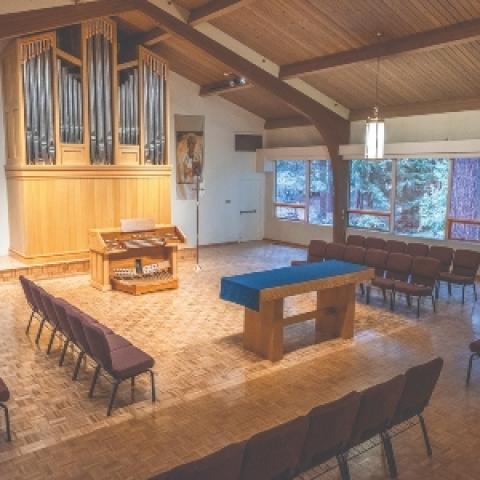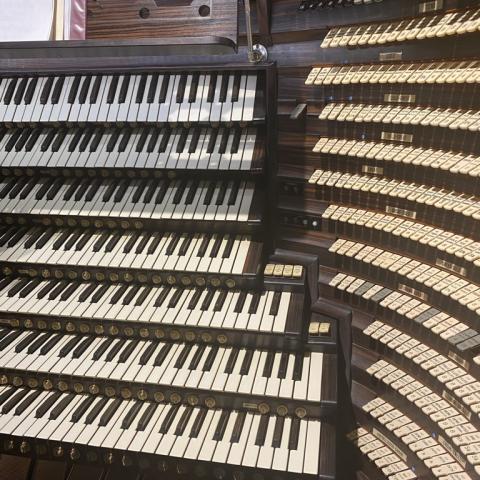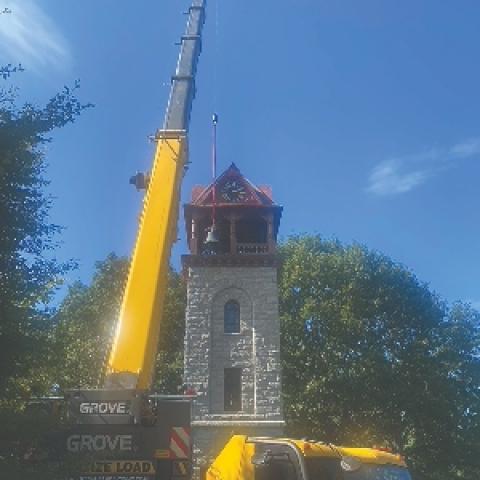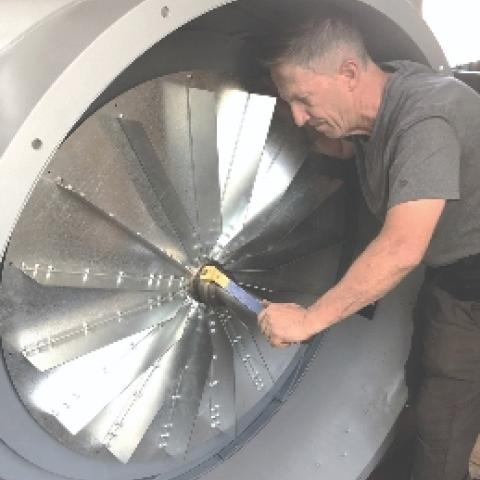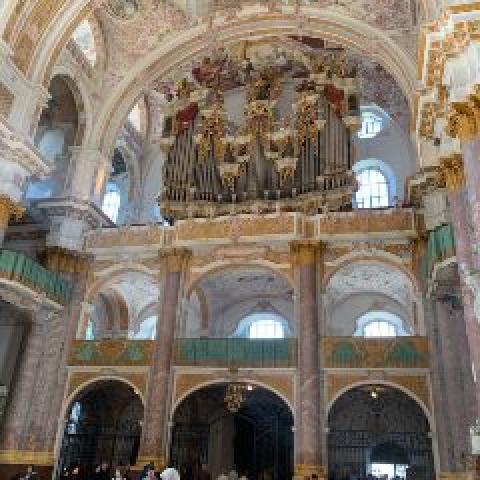
Five manuals? Are you kidding?
Most organs around the world have two manual keyboards and a pedalboard. Three manual organs are common, as are “four-deckers,” especially in big cities, but organs with five manuals are rare. What on earth do you do with five manuals? You only have two hands, and while clever organists can play two keyboards at once by “thumbing down” a melody, the cleverest could not possibly manage more than four at once. Can you even reach the top keyboard?
During my career of servicing organs, I always noticed that the top keyboard of a four-manual console shows considerably less wear than the others. In fact, when restoring an organ console, it is possible to swap the well-worn Great keyboard with the less-used Solo. Is it laziness or just more comfortable and convenient to couple the fourth-manual Solo division to a lower keyboard? A console with five keyboards is certainly connected to a very large organ, so it is always a bewildering thing with hundreds of drawknobs, tilting tablets, pistons, indicator lights, and gadgets not found on more usual consoles.
I am thinking about five-manual organs because in the last two weeks I have visited three of them: the Austin in Merrill Auditorium of City Hall in Portland, Maine; the Kilgen at Saint Patrick’s Cathedral in New York; and the Aeolian-Skinner at Saint Bartholomew’s Church in New York. The three instruments are radically different, each with a distinctive personality, and each was demonstrated by a brilliant “house” organist with a particular point of view.
Vacationland
My wife Wendy and I divide our time between homes in New York City and coastal Maine. New York is a bustling, booming metropolis alive with culture and variety, busily regaining its life after the horrors of Covid, and in Maine we are in a verdant rural area alive with the beauty of the ocean and the continual motion of wind and tide.
The population of New York City is 8.5 million people, 1.63 million of whom live in the twenty-three square miles of Manhattan, which is 71,125 people per square mile. The State of Maine has 1.34 million residents, 300,000 fewer than Manhattan. Maine covers 35,385 square miles, so the population density is about thirty-eight people per square mile. When we were in New York for the first time after our Covid exile, I commented to Wendy, “We’ve seen more people in the last three blocks than in the last fifteen months.”
Portland is the largest city in Maine with about 66,500 residents—there are probably blocks in Manhattan with more people—but it is a beautiful city with a symphony orchestra, several fine choral societies, an art museum, opera, and ballet, and one of America’s two active municipal organists. James Kennerley presides over the 104-rank Austin organ in Merrill Auditorium, a gift to the city by Portland native and publishing magnate Cyrus H. K. Curtis. Curtis gained his middle initials from Hermann Kotzschmar, a brilliant organist and conductor who was the center of the musical life of Portland at the turn of the twentieth century, and the great and good friend of Curtis’s father. He memorialized Kotzschmar with the gift of the organ, dedicating his gift to the city as the Kotzschmar Organ. Today, a nonprofit group called the Friends of the Kotzschmar Organ (FOKO) maintains and promotes the organ.
On June 14, 2021, the FOKO board held its annual meeting in person, the first non-Zoom meeting since “before.” We met in the large rehearsal hall of Merrill Auditorium, so there was plenty of space to comply with the city’s requirements of masks and social distancing. (Should we call that MSD for simplicity?) It was a joy to see friends and colleagues, to choose elbow and fist bumps over handshakes, and to discuss the business of the organization. After the meeting, municipal organist James Kennerley treated us to a half-hour recital on the great organ. We sat in folding chairs on the auditorium stage, up close and personal with the vast and mighty instrument as James demonstrated how he has learned to adapt the music of Bach to its resources. He is widely known as a prolific performer of early music, and he noted that his teachers would have questioned his registration when he played a brief chorale prelude on the Harp alone.
The Kotzschmar Organ has six manual divisions (Great, Swell, Orchestral, Solo, Antiphonal, and Echo) and originally had a four-manual console in the well-known Austin style with stop tablets and the “ka-chunk” combination action. The five-manual console was built in 2000, allowing more complete control over the organ. Why do you need five manuals? Obviously, you don’t. But imagine that you would like to have two manual registrations on both the main organ and in the Echo and Antiphonal divisions, which are located above the ceiling at the rear of the auditorium, along with a colorful solo combination for comment. Boom. Five manuals. The organ is loaded with colorful voices and includes a full theatre-style toy counter.
One of FOKO’s annual traditions is the presentation of a silent movie with organ accompaniment on Halloween, making use of the organ’s second personality as a theatre organ. Last year’s Covid Halloween film was The Hunchback of Notre Dame presented at the drive-in movie theater in Saco, Maine.
Merrill Auditorium seats about 1,900 people in a classic concert-hall layout with two balconies. I do not know the exact dimensions of the hall, but I will guess that no seat is more than 150 feet from the organ, and many are within 100 feet. It is a powerful organ—most of the instrument is on ten inches of wind pressure—and the big 32′ voices really shake the place. It is unusual to hear such a large organ in such an intimate space.
James’s appointment as municipal organist immediately followed the comprehensive renovation of the organ completed by Foley-Baker, Inc., in 2014. The organ is like new, sparkling both inside and out, up to any demands of the most creative organist. Visit www.foko.org where you will find concert schedules, stoplist, history, and a description of the renovation project.
James had some comments about the fifth manual:
In Portland, the top manual gets more use than most similarly sized consoles. Because it controls, by default, the Antiphonal and Echo divisions, there is a logical spacial separation of manual and pipe location (the main case vs. 100 feet up in the ceiling!). Additionally, because it is truly conceived as an orchestral instrument—every manual division has something important to offer to the ensemble sound—I find that I’ll often have the four “main” divisions coupled together. Having that fifth manual available saves having to worry about Unisons Off, etc. Reminded of the North German tradition of extensive improvised choral fantasias, I find the fifth manual gets most use when improvising.
He went on to say that when he was an assistant organist at Saint Paul’s Cathedral in London, they reserved the fifth manual “almost exclusively” for the West End trumpets, not the sort of thing you would want to forget having coupled down to another manual, especially given the console placement where the organist would be the last to hear!
Fifth Avenue
Saint Patrick’s Cathedral, located at Fifty-Third Street and Fifth Avenue, is among the largest ecclesiastical buildings in the United States and is the second largest in New York. It is an important tourist mecca visited by more than five million people each year. During my visit in the waning days of Covid restrictions, there were hundreds of people milling about both during and between Masses. The organ was originally built by Geo. Kilgen & Son and now has 116 stops and 142 ranks, located in a huge gallery at the west end, under the rose window.
The interior of the church is 332 feet long and 174 feet wide at the transepts. (The Cathedral of Saint John the Divine on the Upper West Side is 601 feet long inside!) I did not have a tape measure with me, but with my long career of removing organs from big churches, I will hazard a guess that the balcony is more than thirty feet off the floor of the nave and the organ is twenty feet above the console. The sound of the huge organ is monumental in scale with the room. At Merrill Auditorium, the closest seats are within fifty feet of the organ, and they face the main body of the instrument directly at eye level. At Saint Patrick’s, the closest seats are probably fifty feet away, directly below the organ, and the sound of the organ soars above them.
My host was Michael Hey, associate organist and director of music for the cathedral. We spent an hour and a half listening to and discussing the organ before a noon Mass. One of his demonstration pieces became the prelude for the Mass, and while tourists swirled in the back half of the church and down the side aisles, priests and cantor in the chancel led the celebration for a large congregation. It was surreal to be so far from the altar, the priests, and the congregation. I could hear the cantor singing, standing at a microphone two hundred feet away, but I could barely hear the congregation singing.
Throughout my career, people have responded to learning what I do for a living with their travel stories. “When we were in London, we walked into Saint Paul’s . . . .” “When we were in Paris, we walked into Notre Dame . . . and someone was playing the organ. It was incredible. I’ll never forget that sound . . . .” Michael knows that he’s the guy playing the organ when those millions of tourists walk into the church. He thinks of the person from Argentina or Brazil who always dreamed of visiting Saint Patrick’s. He is inspired by the sense that his playing brings that visit to life and those visitors will take the experience home with them.
There is a swell little elevator from the narthex to the organ loft, a nice discovery on a very hot day, and a spiral stone stairway from the loft to the organ chambers and ultimately to the south tower. Most of the organ is located behind the magnificent organ façade, and we climbed ladders to the highest level where one can stand just under the great rose window and look down the length of the nave. Two full-length 32′ stops (Diapason and Contra Bombarde) lie on their sides in the north triforium, and when you walk past those two immense stops you reach the Nave Organ, located in two chambers near the great crossing. Are you paying attention? I’ve just left the organ loft, walked eighty feet to the Nave Organ, and another twenty-five to get to the place in the triforium where nave and transept meet, and there’s a commanding view of the great crossing, nave, and north transept.
The scale of the building and the organ encourages one to play to the acoustics. Michael’s hands are off the keys as much as on; he lifts his hands to separate notes, allowing the vast acoustics to connect them. It is light years from the practice room and from most usual church organs. There is nothing usual about Saint Patrick’s Cathedral and its organ.
The fifth manual is home to the nineteen-stop Nave Organ that includes a principal chorus, a Gamba with Celeste, a couple flutes, a Vox Humana, Oboe, a big chorus of reeds and the Triforium Trumpet on eighteen inches of wind. Stand back. Michael is a tall, lanky guy, and when I asked him how often he plays on the fifth manual, he put his hands right on it and said it is really about how well your shirt fits. If the shirt is a little tight at the shoulders or the lunch a little too much, it is not as easy to get up there. But since the Nave Organ is so separate from the gallery organ, it makes sense to use the top keyboard to play the organs against each other. It was obvious as he played that the top manual is well within reach.
Michael’s affinity with the organ, the giddy climb high into the organ, and the thrill of hearing the mighty instrument project its tones through the lofty space was a great prelude to a lovely Thai lunch a few blocks away, a fitting end to a wonderful visit. You can find the stoplist and read about this remarkable organ at nycago.org/Organs/NYC/html/StPatrickCath.html.
“Have you seen the well-to-do?”
Up and down Park Avenue . . . .1 Saint Bartholomew’s Church (affectionately known as St. Bart’s), another of New York’s greatest, is four blocks from Saint Patrick’s at Fifty-First Street and Park Avenue. Designed by Bertram Goodhue in a Byzantine-Romanesque style, it is markedly different in form and decoration from the many Gothic-inspired buildings throughout the city. With 225 ranks, the five-manual organ is the largest instrument in the city. Unlike the organs at Merrill Auditorium and Saint Patrick’s that are still in their original form with judicious additions, the St. Bart’s organ reflects an evolution, containing important elements from previous organs by Odell, Hutchings, and the Skinner Organ Company (Ernest Skinner), all summarized and crowned by what is the last project completed by the Aeolian-Skinner Organ Company before it closed in 1972.
The most unusual feature of this landmark organ is the eighteen-stop Celestial division that plays from the fifth manual, built by the Skinner Organ Company in 1930 and installed above the dome, sixty-six feet above the floor of the nave. It originally included a large principal chorus, solo and soft flutes, strings and celestes, Vox Humana, a big assortment of reeds including Harmonic Trumpet, Tuba, and Corno di Bassetto, so the division includes both soft ethereal voices and powerful reeds, topped off with a seven-rank Harmonic Mixture. Half of the space above the ornamental dome is occupied by the organ, the other half of the outer dome is covered with hard plaster forming a huge resonating chamber, so the sound is blended as a heavenly chorus, providing huge climaxes to the effect of the combined chancel and gallery organs.
Paolo Bordignon, organist and choirmaster at St. Bart’s, is a devoted student of the organ he plays. As we walked around the church together, Paolo pointed out the spectacular carvings of the gallery organ case, all produced by master carver Frank Walter. You can follow a link to Mr. Walter’s work at stbarts.org/music/the-organs/. The interior of the building is wide and open as there are no columns. The impression of great height is enhanced by that dome, a huge interior space above the vaulted ceilings.
While Saint Patrick’s has the rolling acoustics you would expect in such a big room, in spite of its great size the acoustics at St. Bart’s are surprisingly intimate with “just enough” reverberation, allowing the brilliant classic choruses of the chancel organ to speak clearly throughout the room. Paolo demonstrated what he considers to be the genius of this organ, the rich Romantic voices from earlier instruments that include harmonic flutes, luscious strings, and wide-mouth diapasons combined with the brilliant neo-classical choruses of the 1972 Aeolian-Skinner. While some such instruments can only be described as hodge-podge (we sometimes say “Bitsa,” as in bitsa this and bitsa that), the St. Bart’s organ, enhanced by the marvelous building, is a cohesive, convincing whole.
Paolo gave me a detailed demonstration of the value of having so many stops by playing the same five or ten measures of various pieces over and over, using a different registration each time. Comparing and combining four or five sets of celestes, for example, showed what a kaleidoscope of sound a large organ can be. The luxury of choosing between harmonic flutes or between seven or eight lyrical colorful solo reed voices is the experience of playing on such a large instrument.
I did not need to ask Paolo about using the fifth manual. He repeated several times how important the Celestial division is to the whole of the organ, and as he played for me, he was up and down on all five keyboards. He is not especially tall, and he was wearing a jacket. Must have been a pretty good fit. Nothing to it.
When is enough enough?
It is just a couple months since I wrote about my visit to the world’s only seven-manual organ at Boardwalk Hall in Atlantic City, New Jersey. The design of that organ stretches the imagination ever further with its eighty-five- and seventy-three-note keyboards. The six-manual console at the Wanamaker Store (now Macy’s) in Philadelphia is a world wonder, especially when Grand Court Organist Peter Conte is playing. Skinner and Aeolian-Skinner built five organs with five-manual consoles (St. Bart’s, Riverside Church, Curtis Institute, Mormon Tabernacle, and Cleveland Public Auditorium). The Kotzschmar Organ and St. Bart’s are joined by the Hazel Wright Organ in Christ Cathedral (formerly Crystal Cathedral), the First Congregational Church in Los Angeles, and Calvary Church, Charlotte, North Carolina, as among the five-manual organs in the United States. With Saint Patrick’s, that makes eleven of them, and by the way, there are two identical five-manual consoles at Saint Patrick’s, one in the rear gallery where Michael received me, the other in the chancel. This list is off the top of my head. I am not claiming it as definitive. Let me know how many I am missing. Five manuals is a lot, but my little tour proved that for a skilled and inquisitive organist and a very large organ, it’s nothing like too many.
Notes
1. Irving Berlin, “Puttin’ On the Ritz.”

